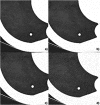Ultralow-dose CT with tin filtration for detection of solid and sub solid pulmonary nodules: a phantom study
- PMID: 26492317
- PMCID: PMC4984934
- DOI: 10.1259/bjr.20150389
Ultralow-dose CT with tin filtration for detection of solid and sub solid pulmonary nodules: a phantom study
Abstract
Objectives: To investigate the diagnostic performance of advanced modelled iterative reconstruction (ADMIRE) to filtered back projection (FBP) when using an ultralow-dose protocol for the detection of solid and subsolid pulmonary nodules.
Methods: Single-energy CT was performed at 100 kVp with tin filtration in an anthropomorphic chest phantom with solid and subsolid pulmonary nodules (2-10 mm, attenuation, 20 to -800 HU at 120 kVp). The mean volume CT dose index (CTDIvol) of the standard chest protocol was 2.2 mGy. Subsequent scans were obtained at 1/8 (0.28 mGy), 1/20 (0.10 mGy) and 1/70 (0.03 mGy) dose levels by lowering tube voltage and tube current. Images were reconstructed with FBP and ADMIRE. One reader measured image noise; two readers determined image quality and assessed nodule localization.
Results: Image noise was significantly reduced using ADMIRE compared with FBP (ADMIRE at a strength level of 5 : 70.4% for 1/20; 71.6% for 1/8; p < 0.001). Interobserver agreement for image quality was excellent (k = 0.88). Image quality was considered diagnostic for all images at 1/20 dose using ADMIRE. Sensitivity of nodule detection was 97.1% (100% for solid, 93.8% for subsolid nodules) at 1/20 dose and 100% for both nodule entities at 1/8 dose using ADMIRE 5. Images obtained with 1/70 dose had moderate sensitivity (overall 85.7%; solid 95%; subsolid 73.3%).
Conclusion: Our study suggests that with a combination of tin filtration and ADMIRE, the CTDIvol of chest CT can be lowered considerably, while sensitivity for nodule detection remains high. For solid nodules, CTDIvol was 0.10 mGy, while subsolid nodules required a slightly higher CTDIvol of 0.28 mGy.
Advances in knowledge: Detection of subsolid nodules is feasible with ultralow-dose protocols.
Figures




Similar articles
-
Ultralow-dose chest computed tomography for pulmonary nodule detection: first performance evaluation of single energy scanning with spectral shaping.Invest Radiol. 2014 Jul;49(7):465-73. doi: 10.1097/RLI.0000000000000037. Invest Radiol. 2014. PMID: 24598443
-
Dose-Optimized Computed Tomography for Screening and Follow-Up of Solid Pulmonary Nodules in Obesity: A Phantom Study.Curr Probl Diagn Radiol. 2017 May-Jun;46(3):204-209. doi: 10.1067/j.cpradiol.2016.07.005. Epub 2016 Aug 2. Curr Probl Diagn Radiol. 2017. PMID: 27662771
-
Evaluation of pulmonary nodules and infection on chest CT with radiation dose equivalent to chest radiography: Prospective intra-individual comparison study to standard dose CT.Eur J Radiol. 2016 Feb;85(2):360-5. doi: 10.1016/j.ejrad.2015.11.036. Epub 2015 Dec 3. Eur J Radiol. 2016. PMID: 26781141
-
IMAGE QUALITY AND POTENTIAL DOSE REDUCTION USING ADVANCED MODELED ITERATIVE RECONSTRUCTION (ADMIRE) IN ABDOMINAL CT - A REVIEW.Radiat Prot Dosimetry. 2021 Oct 12;195(3-4):177-187. doi: 10.1093/rpd/ncab020. Radiat Prot Dosimetry. 2021. PMID: 33778892 Free PMC article. Review.
-
CT protocol optimisation in PET/CT: a systematic review.EJNMMI Phys. 2020 Mar 16;7(1):17. doi: 10.1186/s40658-020-00287-x. EJNMMI Phys. 2020. PMID: 32180029 Free PMC article. Review.
Cited by
-
Ultra-low-dose CT for attenuation correction: dose savings and effect on PET quantification for protocols with and without tin filter.EJNMMI Phys. 2023 Oct 20;10(1):66. doi: 10.1186/s40658-023-00585-0. EJNMMI Phys. 2023. PMID: 37861887 Free PMC article.
-
Potential for Radiation Dose Reduction in Dual-Source Computed Tomography of the Lung in the Pediatric and Adolescent Population Compared to Digital Radiography.Diagnostics (Basel). 2021 Feb 10;11(2):270. doi: 10.3390/diagnostics11020270. Diagnostics (Basel). 2021. PMID: 33578643 Free PMC article.
-
Volumetric assessment of solid pulmonary nodules on ultralow-dose CT: a phantom study.J Thorac Dis. 2019 Aug;11(8):3515-3524. doi: 10.21037/jtd.2019.08.12. J Thorac Dis. 2019. PMID: 31559058 Free PMC article.
-
Low-Dose CT Screening for Lung Cancer: Evidence from 2 Decades of Study.Radiol Imaging Cancer. 2020 Mar 27;2(2):e190058. doi: 10.1148/rycan.2020190058. Radiol Imaging Cancer. 2020. PMID: 32300760 Free PMC article. Review.
-
Towards ultra-low-dose CT for detecting pulmonary nodules using DenseNet.Phys Eng Sci Med. 2025 Mar;48(1):379-389. doi: 10.1007/s13246-025-01520-6. Epub 2025 Feb 10. Phys Eng Sci Med. 2025. PMID: 39928290
References
-
- Gordic S, Morsbach F, Schmidt B, Allmendinger T, Flohr T, Husarik D, et al. . Ultralow-dose chest computed tomography for pulmonary nodule detection: first performance evaluation of single energy scanning with spectral shaping. Invest Radiol 2014; 49: 465–73. doi: 10.1097/RLI.0000000000000037 - DOI - PubMed
-
- National Research Council (US) Board on Radiation Effects Research. Health Risks Expo Low Levels Ionizing Radiat BEIR VII, Phase Lett Rep. Washington, DC: National Academies Press (US); 1998. Available from: http://www.ncbi.nlm.nih.gov/books/NBK224187/. - PubMed
MeSH terms
Substances
LinkOut - more resources
Full Text Sources
Other Literature Sources
Medical
Miscellaneous

